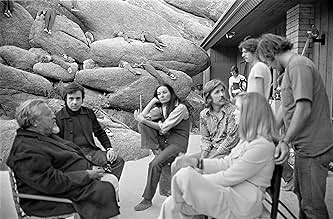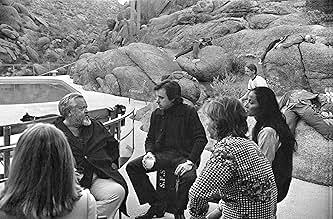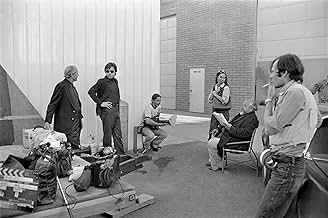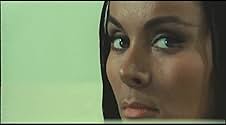NOTE IMDb
6,7/10
8,3 k
MA NOTE
Un réalisateur hollywoodien émerge de semi-exil avec l'intention de terminer son travail sur un film innovant.Un réalisateur hollywoodien émerge de semi-exil avec l'intention de terminer son travail sur un film innovant.Un réalisateur hollywoodien émerge de semi-exil avec l'intention de terminer son travail sur un film innovant.
- Réalisation
- Scénario
- Casting principal
- Récompenses
- 9 victoires et 8 nominations au total
Robert Random
- John Dale
- (as Bob Random)
Avis à la une
Greetings again from the darkness. Film nerds unite! Most of us who (proudly) wear that label have known that filmmaker Orson Welles left a few unfinished projects when he died in 1985. The most famous - or infamous - of these was THE OTHER SIDE OF THE WIND. It was to be the comeback film for Mr. Welles, who had slipped from the artistic throne with his run of TV projects, shorts, and unsuccessful features during the 1960's. Known as a perfectionist, and as someone more dedicated to the filmmaking part more than the "finishing" part, Welles filmed scenes for the movie from 1970-1976, and then picked it back up in the early 1980's to begin the editing process ... a process he never finished.
Best known for his all-time classics CITIZEN KANE (1941) and TOUCH OF EVIL (1958), Welles left mountains of copious production notes, and almost 100 hours of footage in multiple formats, and in both color and black and white stock, on this project that, even today, might best be described as experimental. Over the past 30 years there have been numerous attempts to raise the money required to finish the film, but all fell short until this one spearheaded by Peter Bogdanovich and Beatrice Welles (Orson's daughter).
In what we can only interpret as semi-autobiographical, what we see on screen is the making of a documentary on a legendary director's comeback film (his poke at artsy filmmakers). Clips of the unfinished film are shown throughout, while an industry party plays out, and numerous documentary filmmakers capture the scene from various angles with their always-present cameras. Got that? Don't worry, it takes at least a few minutes as a viewer to get the rhythm and layers of what's unfolding before our eyes.
John Huston (himself an industry legend with 2 Oscars and 15 nominations) plays director Jake Hannaford, who is walking the fine line between Hollywood power and has-been. It's his 70th birthday party, and Hannaford is compared to Hemingway (a description that better fit Huston than Welles), silently endures insinuations of his closeted homosexuality, desperately seeks funding to finish his film, and skulks around his own party winding through the hangers-on and those waiting for the final curtain.
Hannaford's artsy film within a film, at least the clips we see, feature an inordinate amount of nudity from the leading lady (played by Welles 4th wife and the film's co-writer Oja Kodar), and some ultra-coolness from the lead actor John Dale (played by Robert Random). Part of Hannaford's desperation (both professional and persona) stems from a James Dean-type Dale walking off the set mid-picture.
Guests at the party include Peter Bogdanovich as director Brooks Otterlake, a young director once mentored by Hannaford. It's an example of the student becoming the teacher. Susan Strasberg (daughter of famed acting coach Lee Strasberg) plays film critic Juliet Riche, a thinly-veiled portrait of Welles nemesis Pauline Kael. Other familiar faces in the cast include: Lilli Palmer, Mercedes McCambridge (Oscar winner), Edmond O'Brien (Oscar winner), Cameron Mitchell, Paul Stewart (from CITIZEN KANE), Tonio Selwart, Geoffrey Land, Norman Foster, Dennis Hopper (2 Oscar noms), Claude Chabrol, Stafford Repp (Sgt O'Hara from "Batman" series), plus Cameron Crowe (Oscar winner), William Katt, Frank Marshall (5 Oscar noms), Rich Little, Leslie Moonves (recently fired in disgrace CBS President), and Paul Mazursky (5 Oscar noms). It's fascinating to see so many we recognize from more than 40 years ago. Of course, it's Huston, with his face that's made for black and white film, who is the dominating figure (his scenes were filmed prior to his work on CHINATOWN).
It's easily viewed as a satire on the film industry, and it's quite a fun, messy-by-design, now retro look at a fragile industry - and the even more fragile people who make movies. Welles' love/hate relationship with the industry takes on an art form. He shows what's good and what's deplorable. Is it an experimental movie commenting on the post-studio world of independent filmmaking, or is it an iconic filmmaker, glory days behind him, in the midst of self-reflection. Perhaps it's both. In addition to Welles' early editing efforts, Oscar winning editor Bob Murawski (THE HURT LOCKER) was brought in to finish up what can now be described as a master class in film editing. It's a wild ride for us film nerds. Are you ready to join us?
Best known for his all-time classics CITIZEN KANE (1941) and TOUCH OF EVIL (1958), Welles left mountains of copious production notes, and almost 100 hours of footage in multiple formats, and in both color and black and white stock, on this project that, even today, might best be described as experimental. Over the past 30 years there have been numerous attempts to raise the money required to finish the film, but all fell short until this one spearheaded by Peter Bogdanovich and Beatrice Welles (Orson's daughter).
In what we can only interpret as semi-autobiographical, what we see on screen is the making of a documentary on a legendary director's comeback film (his poke at artsy filmmakers). Clips of the unfinished film are shown throughout, while an industry party plays out, and numerous documentary filmmakers capture the scene from various angles with their always-present cameras. Got that? Don't worry, it takes at least a few minutes as a viewer to get the rhythm and layers of what's unfolding before our eyes.
John Huston (himself an industry legend with 2 Oscars and 15 nominations) plays director Jake Hannaford, who is walking the fine line between Hollywood power and has-been. It's his 70th birthday party, and Hannaford is compared to Hemingway (a description that better fit Huston than Welles), silently endures insinuations of his closeted homosexuality, desperately seeks funding to finish his film, and skulks around his own party winding through the hangers-on and those waiting for the final curtain.
Hannaford's artsy film within a film, at least the clips we see, feature an inordinate amount of nudity from the leading lady (played by Welles 4th wife and the film's co-writer Oja Kodar), and some ultra-coolness from the lead actor John Dale (played by Robert Random). Part of Hannaford's desperation (both professional and persona) stems from a James Dean-type Dale walking off the set mid-picture.
Guests at the party include Peter Bogdanovich as director Brooks Otterlake, a young director once mentored by Hannaford. It's an example of the student becoming the teacher. Susan Strasberg (daughter of famed acting coach Lee Strasberg) plays film critic Juliet Riche, a thinly-veiled portrait of Welles nemesis Pauline Kael. Other familiar faces in the cast include: Lilli Palmer, Mercedes McCambridge (Oscar winner), Edmond O'Brien (Oscar winner), Cameron Mitchell, Paul Stewart (from CITIZEN KANE), Tonio Selwart, Geoffrey Land, Norman Foster, Dennis Hopper (2 Oscar noms), Claude Chabrol, Stafford Repp (Sgt O'Hara from "Batman" series), plus Cameron Crowe (Oscar winner), William Katt, Frank Marshall (5 Oscar noms), Rich Little, Leslie Moonves (recently fired in disgrace CBS President), and Paul Mazursky (5 Oscar noms). It's fascinating to see so many we recognize from more than 40 years ago. Of course, it's Huston, with his face that's made for black and white film, who is the dominating figure (his scenes were filmed prior to his work on CHINATOWN).
It's easily viewed as a satire on the film industry, and it's quite a fun, messy-by-design, now retro look at a fragile industry - and the even more fragile people who make movies. Welles' love/hate relationship with the industry takes on an art form. He shows what's good and what's deplorable. Is it an experimental movie commenting on the post-studio world of independent filmmaking, or is it an iconic filmmaker, glory days behind him, in the midst of self-reflection. Perhaps it's both. In addition to Welles' early editing efforts, Oscar winning editor Bob Murawski (THE HURT LOCKER) was brought in to finish up what can now be described as a master class in film editing. It's a wild ride for us film nerds. Are you ready to join us?
It took 40 years to make. Orson Welles never lived to see it completed. It's sad, but in retrospect, I see why. The Other Side of the Wind is brilliant in it's own little way, but it's far too esoteric. This film was for an audience, but we certainly aren't it. This is Orson Welles, and his film cohorts, fed up with the Hollywood system, and throwing up their middle fingers at them. At the same time, Welles was searching to make a masterpiece far ahead of it's time. What we get is the story of the premiere of a legendary filmmaker's last film. The film-within-the-film, also titled The Other Side of the Wind, is a colorful and erotic psychedelic fever dream about a Native American woman. I enjoyed this portion much more. You can see the imagination and enthusiasm for making something new and far-out from these scenes. The scenes that wrap around the film-within-a-film are in the style of a documentary, as we see industry folks and journalists quipping and arguing with each other. John Huston stars as Jake Hannaford, the jaded has been hot shot director who is obviously supposed to represent Welles himself. Huston is the brightest part of these scenes. On the whole, they are less imaginative, and feel so insular. It's unbalanced, and that's what really took me out of it. Historically, this is really fascinating stuff. To better understand it, I must consult the making-of companion doc on Netflix.
Years ago I saw a documentary that included a scene from a never-released Orson Welles film, The Other Side of the Wind. It was remarkably modern, a kaleidoscopic, eccentric work that was surprising for someone Welles age.
It wasn't until 2020 that I learned the film had actually been pulled together and released.
The cinema-verite style is explained as the result of pulling together footage from various documentarians and journalists video. The film begins with various hangers on of a famous director traveling to his party while elsewhere an investor is watching footage from his current, unfinished film.
This is actually the weakest part of the movie. The individual scenes are confusing and the way they are intercut with the film-within-a-film just add to the confusion. Apparently Welles had rough-cut about half the movie by the time he died, and my suspicion is this first part was not part of that rough cut, since it's weaker. Just a guess.
The film-within-a-film seems to be a parody of trippy, avant-garde, 60s filmmaking. I take it as Welles' portrayal of an old director past his glory days trying to create something hip.
The movie gets its footing when the director's party starts. There is a lot of striking B&W footage cut in and John Huston as the director is a powerful force. The party is to screen his movie, such as it is, and while it is essentially a plotless bit of nonsense with tons of gratuitous nudity, it does have some striking imagery, such as a scene set in slatted shadows and another involving a beaded necklace.
The surrounding film doesn't have much story. It's mainly about the director charming or dueling with various characters who want something from him. Things are hinted but rarely spelled out.
Welles was a genius, so even his worst movies, like Mr. Arkadin, are splashed with brilliance. Other Side of the Wind has a remarkable style and is generally fascinating, but it's not always satisfying and the film-within-a-film takes up more time than it probably should have.
If you're a fan of Orson Welles, or just a fan of cinema, this is a must-see. Yes, the movie would have been more impressive if it had been released in the early 70s, when it was filmed, but even today in a world full of found-footage movies this is still remarkable.
It wasn't until 2020 that I learned the film had actually been pulled together and released.
The cinema-verite style is explained as the result of pulling together footage from various documentarians and journalists video. The film begins with various hangers on of a famous director traveling to his party while elsewhere an investor is watching footage from his current, unfinished film.
This is actually the weakest part of the movie. The individual scenes are confusing and the way they are intercut with the film-within-a-film just add to the confusion. Apparently Welles had rough-cut about half the movie by the time he died, and my suspicion is this first part was not part of that rough cut, since it's weaker. Just a guess.
The film-within-a-film seems to be a parody of trippy, avant-garde, 60s filmmaking. I take it as Welles' portrayal of an old director past his glory days trying to create something hip.
The movie gets its footing when the director's party starts. There is a lot of striking B&W footage cut in and John Huston as the director is a powerful force. The party is to screen his movie, such as it is, and while it is essentially a plotless bit of nonsense with tons of gratuitous nudity, it does have some striking imagery, such as a scene set in slatted shadows and another involving a beaded necklace.
The surrounding film doesn't have much story. It's mainly about the director charming or dueling with various characters who want something from him. Things are hinted but rarely spelled out.
Welles was a genius, so even his worst movies, like Mr. Arkadin, are splashed with brilliance. Other Side of the Wind has a remarkable style and is generally fascinating, but it's not always satisfying and the film-within-a-film takes up more time than it probably should have.
If you're a fan of Orson Welles, or just a fan of cinema, this is a must-see. Yes, the movie would have been more impressive if it had been released in the early 70s, when it was filmed, but even today in a world full of found-footage movies this is still remarkable.
So I reckon this film is sorta Orson Welles' version of Fellini's '8 1/2', a self-portrait, aiming at tearing down the facade in front of the man in favor of a multi-faceted, multi-personal panopticum, which might just be another facade.
In comparison to Fellinis movie, 'The Other Side of the Wind' is equally carnvalesque, more deconstructivist - individual roles seem to disolve or fade into each other in the more - more prone to abandon narrative structure, less cheerful, but ultimately more bitter. Whereas Fellini -- through Mastroianni -- seems to comment his own shortfalls as an artist and his faustian, sexual desire with a mischievous, but upbeat wink in the end, the narrator's final epigramm as well as the title of Welles' last movie seems to suggest a more macbethian philosophy: it was all a story full of sound and fury, signifying nothing, and the acclaimed director is nothing but the other side of the wind, blowing in a conversation.
In comparison to Fellinis movie, 'The Other Side of the Wind' is equally carnvalesque, more deconstructivist - individual roles seem to disolve or fade into each other in the more - more prone to abandon narrative structure, less cheerful, but ultimately more bitter. Whereas Fellini -- through Mastroianni -- seems to comment his own shortfalls as an artist and his faustian, sexual desire with a mischievous, but upbeat wink in the end, the narrator's final epigramm as well as the title of Welles' last movie seems to suggest a more macbethian philosophy: it was all a story full of sound and fury, signifying nothing, and the acclaimed director is nothing but the other side of the wind, blowing in a conversation.
Here it is, if anybody wants to see it.
Were you compelled by the character study of Citizen Kane? Were you thrilled by Touch of Evil? Then get ready for something unlike any of those or unlike anything. This is the mockumentary before Reiner or Guest, the improvisational dramedy before Apatow.
The entire point of this movie is that there's no point to this movie. Here is Orson Welles's most talked about movie about talking about a movie. His film about a film within a film. Orson Welles deliberately subverts Orson Welles to make an art film contained within an art film making fun of art films. John Huston plays John Huston playing Orson Welles as Orson Welles. Peter Bogdanovich plays himself as his own ripoff. There's a party celebrating a celebrated filmmaker making a film making fun of filmmakers. Nothing happens. So much happens. We learn everything about a legendary director about whom we learn nothing.
This film is a glimpse into the psyche of a filmmaker who wants to make films but has no idea how to keep making films. He wants to be commercially successful without compromising his integrity. He wants to make personal films for an impersonal audience. He wants to make something sexy despite being prudish. This movie isn't really for anyone; this movie is really for everyone.
It wasn't until the end of his life that Orson Welles realized the most important story he needed to tell was his own. It's a story whose only concern is that it was told, whether or not you like it. So watch it. Or don't. This movie doesn't care either way.
And if this review left you feeling confused, then I gave you an accurate impression of the film.
Were you compelled by the character study of Citizen Kane? Were you thrilled by Touch of Evil? Then get ready for something unlike any of those or unlike anything. This is the mockumentary before Reiner or Guest, the improvisational dramedy before Apatow.
The entire point of this movie is that there's no point to this movie. Here is Orson Welles's most talked about movie about talking about a movie. His film about a film within a film. Orson Welles deliberately subverts Orson Welles to make an art film contained within an art film making fun of art films. John Huston plays John Huston playing Orson Welles as Orson Welles. Peter Bogdanovich plays himself as his own ripoff. There's a party celebrating a celebrated filmmaker making a film making fun of filmmakers. Nothing happens. So much happens. We learn everything about a legendary director about whom we learn nothing.
This film is a glimpse into the psyche of a filmmaker who wants to make films but has no idea how to keep making films. He wants to be commercially successful without compromising his integrity. He wants to make personal films for an impersonal audience. He wants to make something sexy despite being prudish. This movie isn't really for anyone; this movie is really for everyone.
It wasn't until the end of his life that Orson Welles realized the most important story he needed to tell was his own. It's a story whose only concern is that it was told, whether or not you like it. So watch it. Or don't. This movie doesn't care either way.
And if this review left you feeling confused, then I gave you an accurate impression of the film.
Le saviez-vous
- AnecdotesThe movie was filmed between 1970 and 1976, with editing continuing into the 1980s. When he died in October 1985, Welles left behind nearly 100 hours of footage and a work print consisting of assemblies and a few edited scenes.
- GaffesIn one confrontational scene, Brooks Otterlake, who Gregory Sierra's character, Jack Simon, refers to as, "Kid", is simultaneously Peter Bogdanovich and Rich Little. This is small overlap is because Rich Little was originally cast as the black turtleneck wearing, voice imitating director, Brooks Otterlake. However Bogdanovich replaced him, and Little's part was reduced to that of a Party Guest.
- Citations
[last lines]
Jake Hannaford: Who knows, maybe you can stare too hard at something, huh? Drain out the virtue, suck out the living juice. You shoot the great places and the pretty people... All those girls and boys. Shoot 'em dead.
- Crédits fousAfter the end credits, Hannaford's voice is heard saying "Cut"
- ConnexionsFeatured in AFI Life Achievement Award: A Tribute to Orson Welles (1975)
- Bandes originalesLes Délinquants
Written and performed by Michel Legrand
Published by WB Music Corp. o/b/o Productions,
Michel Legrand + Editions Royalty
Courtesy of Decca Records France
Under license from Universal Music Enterprises
Meilleurs choix
Connectez-vous pour évaluer et suivre la liste de favoris afin de recevoir des recommandations personnalisées
- How long is The Other Side of the Wind?Alimenté par Alexa
Détails
- Date de sortie
- Pays d’origine
- Site officiel
- Langues
- Aussi connu sous le nom de
- The Other Side of the Wind
- Lieux de tournage
- Sociétés de production
- Voir plus de crédits d'entreprise sur IMDbPro
- Durée2 heures 2 minutes
- Couleur
- Mixage
Contribuer à cette page
Suggérer une modification ou ajouter du contenu manquant

Lacune principale
By what name was De l'autre côté du vent (2018) officially released in India in English?
Répondre




































